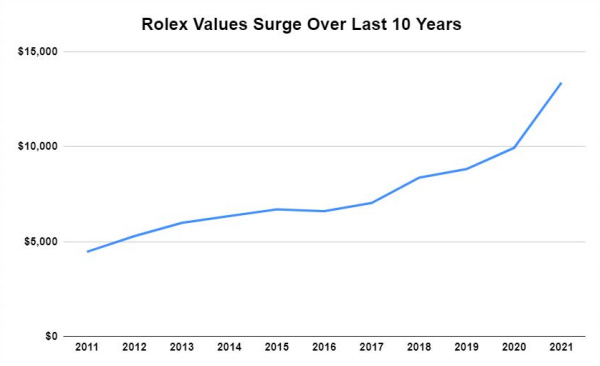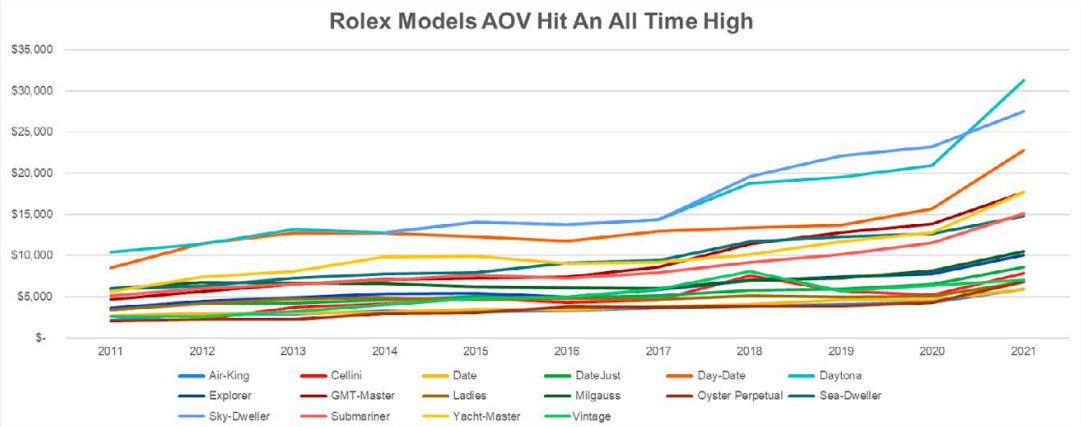A report we received last week from American pre-owned specialist Bob’s Watches shows that investing in Rolex timepieces ten years ago would have delivered a better return than mainstream asset classes over that period.
Like many statistics, that statement is both true and misleading at the same time.
Also in common with most conclusions drawn from diverse statistics, the devil is in the detail.
Bob’s Watches compared the average price rise of pre-owned Rolex watches against traditional asset classes including gold, the Dow Jones Industrial Average stock market and real estate based on median sales price data for houses sold in the United States from the Federal Reserve Economic Data (FRED) database.
The average price of a used Rolex watch has risen almost threefold from under $5,000 in 2011 to more than $13,000 by the end of 2021.
This does, indeed beat the gold, real estate and stock market indexes Bob’s Watches used for comparison.
Bob’s Watches also provides a graph showing price rises for 14 Rolex collections, plus a single category for ladies watches and another for vintage pieces.
This is where a sweeping statement about average Rolex price rises over a 10 year period becomes less meaningful, particularly in comparison to big indexes for stock markets and real estate.
The reality is there are plenty of stocks within the Dow Jones Industrial Average that have outperformed the average for all Rolex watches.
Take Tesla, for example. Its stock has risen by over 15,000% in a decade (almost all of the rise in the past two years).
Likewise, there are the unicorn watches within the Rolex range that are distorting the average.
The majority of Rolex references have barely risen in value on the secondary market until the year 2000, and have only risen since the start of the pandemic.
Realistically, a good stock picker would have done a lot better over the past ten years than even a Rolex collector with perfect foresight because trebling your money is not at all unusual over a decade.
My advice is to buy watches because you love them.
By all means trade those watches if you get bored of some pieces and fall in love with others, but using Rolex as part of your retirement plan would be foolish.




Exactly this: “My advice is to buy watches because you love them.”
I can’t help feeling that the whole watch market (at the mid to higher end) has been spoilt for normal watch lovers by those who view watch purchases as purely a financial investment. Watches are to be worn, enjoyed and appreciated – not locked up in safes and strong-rooms.
Just buy the next moonshot like Tesla bro…. just be a “good” trader and beat the index bro… its ez bro
I fully agree with Rob Corder. Watches are not an investment, and meant to be enjoyed. Unfortunately, investors like Kevin O’Leary (Mr. Wonderful) jumped into the market and started buying watches as an “asset class”, and hoarding them since AD’s sell him any Rolex he desires. In response, I refuse to pay double/triple over retail for an ordinary watch like an Oyster Perpetual. I have discovered other beautiful pieces from Omega, Vacheron Constantin, and Breitling that are both available & affordable. If enough of us the watch collecting public do the same, then Rolex prices will reset and come down. Always remember that Rolex makes almost 1,000,000 watches per year, and they are readily available on the grey market (at over retail prices). If enough of us start buying other brands, then Rolex prices will return back down to reasonable levels. If not, I will take my savings from not buying Rolex, and invest these savings in real assets that outperform Rolex watches!
You are exactly right!